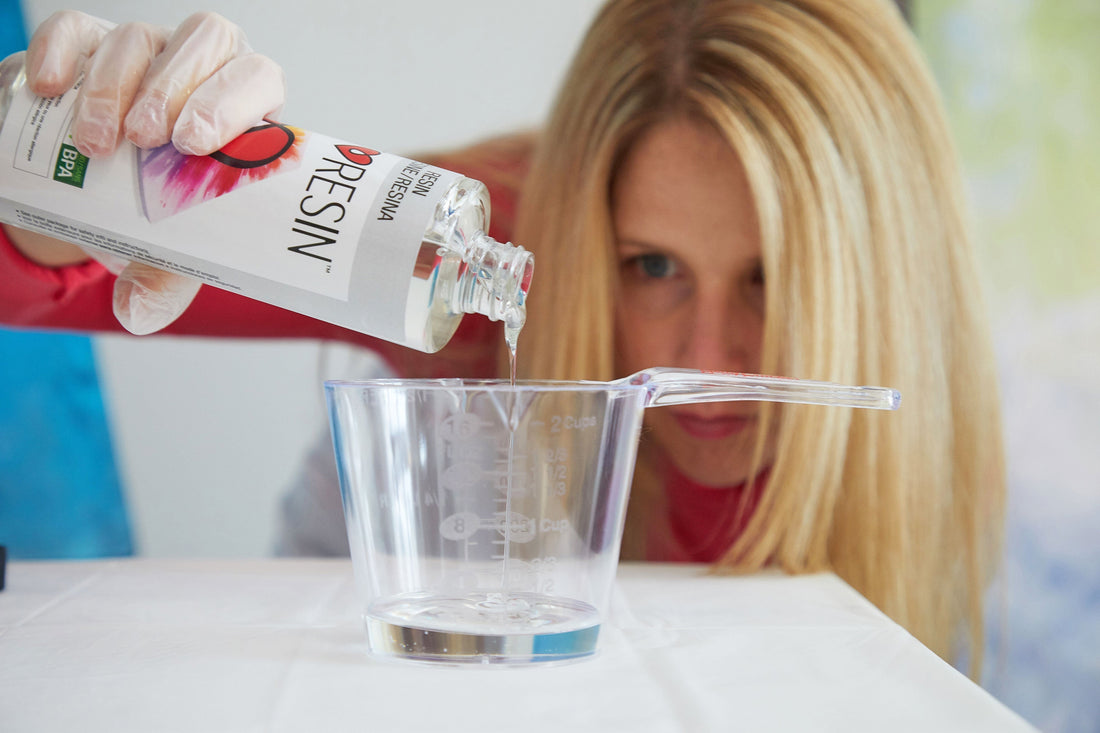ArtResin is non-toxic when used as directed. This means that if you follow the instructions for use, there is no cause for concern or risk to one’s health. We've had our product evaluated by the American Society for Testing and Materials; ArtResin conforms to ASTM D4236: Safe for Home Use.
This is entirely unique for an epoxy resin, as most formulas require scary warning labels to let users know the product is poisonous, carcinogenic and/or hazardous to the environment.
How is it possible that ArtResin is safe when used as directed?
The ArtResin formula is made from the purest raw materials. There are no solvents, cheap fillers, or non-reactive diluents that other epoxy resin brands use to stretch the material. As a result, everything reacts when the resin and hardener are mixed, leaving nothing behind. This means there are no VOCs or fumes coming off the product into the air, which can cause respiratory distress and other serious health problems.
What are ArtResin's instructions for use?
Measure the resin and hardener accurately at a 1:1 ratio and stir for three minutes. Wear gloves and work in a well ventilated space as you do this. The one safety icon we are required to have on our bottles is the exclamation icon to let users know that some people can be allergic to epoxy and it can irritate their skin or cause a rash (this is very rare, however we are required to declare this on our packaging). This is why we must recommend the gloves (plus, it’s sticky so it makes sense from a very basic practical perspective as well). Providing you are working in a well-ventilated space, ArtResin is safe for home use as there are no VOCs or fumes (again, because there are no solvents). See our SDS for more information. We are careful to say that ArtResin is non-toxic WHEN USED AS DIRECTED because obviously any epoxy resin is inedible, and sometimes people lack common sense and equate non-toxicity with edibility.
For the record, ArtResin is NOT edible or potable!
ArtResin’s Non-Toxic Status Can Change With The Addition Of Foreign Products.
If an artist adds foreign products to the ArtResin formula, this can alter the non-toxic status of the mixture. For example, the current trend of adding alcohol ink to resin certainly looks cool and colourful, however alcohol is a solvent… so when artists add alcohol to ArtResin, the product can no longer be classified as non-toxic. Similarly, ArtResin is non-flammable in its liquid form when used as directed, and we do recommend using a Maker’s Studio Torch to pop bubbles. Running a flame quickly and systematically over the entire resin surface will eliminate any trapped bubbles and will not cause a flammability risk, HOWEVER this changes if foreign products have been added to the mixture. Alcohol is flammable and will compromise the non-flammability of virgin liquid ArtResin. For this reason we developed ResinTint, our non-toxic, non-flammable premium colorant for ArtResin. If you're looking for a colorant for your ArtResin and you want to preserve the non-toxic, non-flammable nature of the formula, then ResinTint is the perfect option.
Does Non-Toxic Resin Have Lower Odor Compared To Other Resins?
ArtResin has little to no odor compared to many other epoxy resins on the market. However, it's important to note that odor alone is not a reliable indication of toxicity or non-toxicity. ArtResin's classification as non-toxic is the result of extensive testing and analysis that demonstrate this.
While a low odor creates a more pleasant working environment, the key factor that determines whether a resin is safe for indoor use is its non-toxicity. An epoxy resin can only claim non-toxicity after rigorous testing to show it does not emit harmful fumes or volatile organic compounds (VOCs).
Is There Any Difference in Curing Time Between Toxic and Non-Toxic Epoxy?
Each epoxy resin may have its own specific cure time, so always reference the manufacturer's guidelines provided for the epoxy you're using. Different brands can have varying instructions regarding mixing ratios, stirring duration, pouring depths, and curing times.
Do Non-Toxic Resins Have Different Properties Than Traditional Resins?
Yes, the biggest difference between traditional resin and a non-toxic resin like ArtResin is when it comes to VOCs or Volatile Organic Compounds. ArtResin sets itself apart by containing no solvents or non-reactive diluents. This means that when the resin and hardener are combined, all the components react, leaving nothing behind that can be emitted into into the air and inhaled.
In contrast, other resins on the market may contain fillers to stretch out the ingredients or non-reactive diluents to thin out the formula. These fillers and diluents are often solvents, and when the resin and hardener are mixed, they are not part of the chemical reaction. In other words, they do not bond to the other components in the formula and have nowhere to go except to off-gas as VOCs. ArtResin's formula was intentionally designed to be a clean system - it contains no solvent materials and all parts of the formula react, leaving nothing left to release into the air. For this reason, a non-toxic resin like ArtResin can be used indoors when following label instructions. It's important to note that adding solvent-based materials, such as alcohol ink or other colorants containing solvents, will compromise ArtResin's non-toxic designation.
You will not find any scary skull and crossbones or eye/skin corrosive pictograms in ArtResin's SDS. ArtResin is sticky and may cause skin irritation to those who are allergic to epoxy resin, so we always advise wearing gloves during use. On the other hand, toxic epoxy resins can burn your eyes and skin, can damage your lungs if inhaled and require a respirator during use. Always check the SDS to understand the nature of the epoxy resin you're working with and the necessary safety equipment required before starting any resin project.
Given ArtResin's non-toxic and solvent free formula, it is classified as non-flammable and non-hazardous in its liquid state. This allows it to be transported by air.
Do Non-Toxic Epoxy Resins Contain VOCs?
No, non-toxic epoxy resins like ArtResin do not contain VOCs. ArtResin is a specialized resin formula intentionally designed to be free of harmful ingredients that could be released as VOCs. This makes it a safer choice among resin options.
Non-toxic resin like ArtResin is versatile and suitable for a wide range of applications, ranging from art and crafts to jewelry making and home decor projects. The absence of VOCs means it doesn't release harmful fumes as it cures, creating a safer working environment. Additionally, non-toxic epoxy resin formulations are typically free of substances like bisphenol A (BPA), further enhancing their safety.
When looking for a resin choice that is free from VOCs and hazardous chemicals, non-toxic epoxy resins are a favored selection, making them a safer option for a variety of creative applications.
Do I Need To Take Safety Precautions Even If the Epoxy Resin is Non-Toxic?
Yes, even when working with epoxy resin labeled as non-toxic, it's important to follow safety precautions.
Always consult the manufacturer's instructions and wear the necessary protective gear. For ArtResin, gloves are required during use. A respirator is not required when working in a well-ventilated space.
Proper first aid and clean up instructions are equally important. If ArtResin splashes in your eye, flush it repeatedly with fresh water and seek medical attention. If ArtResin comes into contact with your skin, remove it with an exfoliant soap, or a mixture of salt or sugar and liquid soap. Never clean resin from your skin with a solvent such as alcohol, acetone, hand sanitizer or vinegar, as they can break down the resin and enable your skin absorption. These materials should only be used to clean tools and work surfaces.
Additionally, it's essential to dispose of unused product in accordance with local regulations. Ideally, you should allow any leftover resin or hardener to cure together before discarding in the trash. Do not pour liquid resin or hardener, whether separate or mixed, down the drain.
So, while non-toxic epoxy resins are a safer option, adhering to resin safety practices is essential.
Want to learn more about ArtResin? Read The ArtResin Story.
Do you want to learn more about epoxy resin and safety? Read our guides below:
- Resin Safety Precautions
- Can You Be Allergic To Epoxy Resin?
- ArtResin is Safe for Home Use!
- How Dangerous Is Your Epoxy Resin?
ArtResin: The Original Epoxy For Resin Art.

